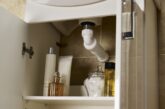
At a glance
For a domestic refurbishment project an alternative, cost effective heating solution to radiators was required. As this was a residential property an easy and quick to install system was essential in order to have as little disruption to the house as possible.
The challenge
The area to be heated included a large, open plan kitchen as well as a utility room and entrance hallway. Radiators had previously been used to heat this space, but had failed to provide even heat and were considered unfit for purpose.
Our approach
Underfloor heating was considered the best heating solution, as it provided a cost effective way of heating the space evenly at once, with one system, operating independently from other rooms in the house.
Hep2O Low Build Max was specified, and 250m of 10mm Hep2O pipes were used over five 50m circuits on this project.
Due to the large size of the panels (1,200mm x 600mm x 15mm), and the flexible pipe and simple push fit fittings that make up the Hep2O system, installing the Low Build Max system in this large area was completed in under two days, including laying all panels and pipe, installing the five-port manifold and setting up the programmable thermostat.
The benefits
The system has minimal impact on the height of the floor, allowing for a speedy installation due to minimal disruption to the current structure of the house.
Being able to tile straight on top of the panels was a great bonus too, as this ensured the overall build height was kept to an absolute minimum, ensuring the system was compatible with existing fixtures and fittings.
The panels could be walked on in a matter of minutes, meaning the completion of this project could be carried out in the minimum amount of time.
What they say:
Tiling on top of the new underfloor heating system was able to begin the next day. The result is a striking new space, with an even distribution of heat that has transformed a cold and unwelcoming kitchen into the heart of the home.
About Hep2O Low Build Max
The system gives installers a quick and easy-to-fit heating alternative to radiators, particularly on renovation projects.
The panels have been specially designed to keep overall floor height to an absolute minimum. At just 15mm deep and featuring pre-routed channels for easy pipe placement, it allows UFH to be installed quickly on all refurbishment projects – from kitchen re-fits to new spaces created by knocking walls through – without the need for existing flooring levels to be lowered.
Low Build Max is equally applicable for extensions. The panels are of a large enough size – 1,200mm x 600mm – to allow installers to cover large areas at speed without being too bulky to handle.
As the panels can be neatly trimmed using a hand saw and secured using adhesive, installation is simple and can be carried out by just one person if necessary.
Step-by-Step Guide
![]()
Step one – Prepare the floor by making it as level as possible and clearing any dirt and dust.
![]()
Step two – Choose where to position your manifold. This will then determine the route of the distribution pipes to each circuit. Consider the complete path of the pipe circuits when establishing where to lay the panels – remembering the maximum length of one circuit is 50m.
![]()
Step three – Line up the return and channel panels so your pipe can easily flow through the system.
![]()
Step four – Cut panels to size where necessary using a hand or power saw. Mix adhesive according to the manufacturer’s guidelines and clean floor one last time before applying the adhesive.
![]()
Step five – Apply the adhesive directly to the surface. When handling the panels, do so from the length ends rather than the sides
![]()
Step six – Lay all panels by repeating the above steps. Press gently on each panel to ensure it is secure and in the correct position. Avoid standing on the panels until the adhesive is set, usually 5-10 minutes but refer the instructions on the adhesive.
![]()
Step seven – Attach manifold to required position, ensuring an accessible route for the pipe work.
![]()
Step eight – Unwrap the coil of pipe, following the instructions on the wrapping. Attach the pipe end to the manifold for each circuit needed (see installation guide for more details).
![]()
Step nine – Lay pipe in your chosen circuit taking care you don’t exceed 50m of pipe, leaving enough pipe to return back to the manifold.
![]()
Step ten – Repeat the installation process for all remaining circuits. Refer to separate installation guides for connecting thermostats and controls.
For more information about Hep2O Low Build Max click here.







